News and updates
-
Experimental active matter seminar by Alexandre Morin [2021-06-30]
Flocks in the Wind
Wednesday june 30th at 13h45 CEST
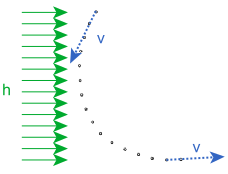 image source: Morin & Bartolo, PRX 2018
image source: Morin & Bartolo, PRX 2018See seminar page for abstract etc.
-
Experimental active matter seminar by François A. Lavegne [2021-05-18]
Group formation and cohesion of active particles with visual perception-dependent motility
Tuesday may 25th at 13h45 CEST
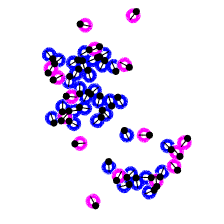 image source: François A. Lavergne
image source: François A. LavergneSee seminar page for abstract etc.
-
Experimental active matter seminar by Daiki Nishiguchi [2021-04-14]
Electrokinetic Janus particles: from self-organized flagella to ordered flocks
Wednesday april 14th at 10h CEST (Paris) / 17h JST (Tokyo)
 image source: Nishiguchi et al New J. Phys. 2017
image source: Nishiguchi et al New J. Phys. 2017See seminar page for abstract etc.
-
Talk on the charmed string [2019-11-13]
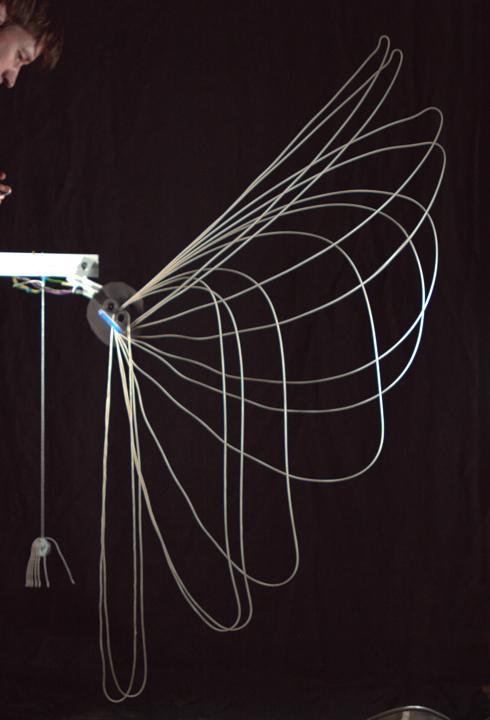
Stationary shapes of the loop for various velocities around the lift transition. The charmed string: self-supporting loops through air drag
28 nov 2019 @ 14h - Salle des séminaires FAST-LPTMS (Bât. 530, salle C.120, 1ER)
The `string shooter’ experiment uses counter-rotating pulleys to propel a closed string forward (Cick here for a video of the experiment by Bruce Yeany). In its steady state, the loop exhibits a transition from a gravity-dominated regime at low velocity towards a high-velocity regime where the string takes the form of a self-supporting loop (see the overlay of shapes). I will show that this transition cannot be explained by inertial effects alone, but depends on the hydrodynamic drag exerted by the surrounding fluid, namely air. The string loop presents a critical point in its lifted state, analogous to a hydraulic jump, separating a supercritical zone where the wave velocity is smaller than the rope velocity, from a subcritical zone where waves propagate faster than the rope velocity. This critical point is also a geometrically singular point both in experiment and theory. I will discuss potential regularisation mechanisms of the string dynamics in the vicinity of this singularity.
Reference
A. Daerr, J. Courson, M. Abello, W. Toutain & B. Andreotti (2019), The charmed string: self-supporting loops through air drag, J. Fluid Mech. 877, R2, DOI:10.1017/jfm.2019.631.
Click here to read the article online for free through Cambridge Core Share
In the press
-
La corde enchantée, un mystère élucidé (David Larousserie, Le Monde du 30 octobre 2019)
-
Étudier, experimenter, publier (Université de Paris)
-
-
Seminar at the Laboratoire Jean Perrin [2018-09-18]
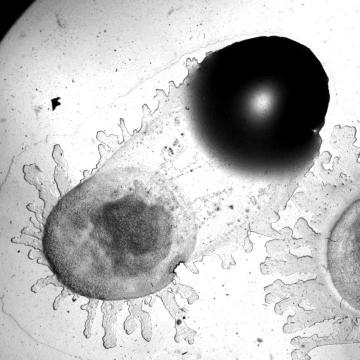
Bacillus subtilis colony `surfing' on gel. Active depinning of bacterial droplets: The collective surfing of Bacillus subtilis
9 oct 2018 @ 11h - LJP, Jussieu - Salle des séminaires 5ème étage, Tour 32-33
How systems are endowed with migration capacity is a fascinating question with implications ranging from the design of novel active systems to the control of microbial populations. Bacteria, which can be found in a variety of environments, have developed among the richest set of locomotion mechanisms both at the microscopic and collective levels.
Recently we discovered a mode of collective bacterial motility in humid environment through the depinning of bacterial droplets. Although capillary forces are notoriously enormous at the bacterial scale, even capable of pinning water droplets of millimetric size on inclined surfaces, bacteria are capable of unpinning contact lines, by harnessing a variety of mechanisms which I will discuss, hence inducing a collective slipping of the colony across the surface. Contrary to flagella-dependent migration modes like swarming, we show that this much faster “colony surfing” still occurs in mutant strains of Bacillus subtilis lacking flagella. The active unpinning seen in our experiments relies on a variety of microscopic mechanisms, which could each play an important role in the migration of microorganisms in humid environment.
Reference:
Hennes, M., Tailleur, J., Charron, G. & Daerr, A. (2017), Active depinning of bacterial droplets: The collective surfing of Bacillus subtilis, Proceedings of the National Academy of Sciences 114(23), 5958-5963.
(A preprint with all of the supplementary information is available on the page of publications, and the movies here or at PNAS).
-
Thesis viva voce of Marc Hennes [2017-11-20]

Bacillus subtilis colony `surfing' on gel. Marc Hennes, whose PhD work I supervised during the past three years, defends his thesis in a Viva Voce that will take place on tuesday november 21st, 2017, at 14h, in the amphithéâtre Pierre Gilles de Gennes in the basement (floor -1) of our Physics building (bâtiment Condorcet, 10 Rue Alice Domon et Léonie Duquet, 75013 Paris).
Part of this presentation will cover our recent article on collective depinning of droplets by bacteria (our paper’s preprint with all of the supplementary information is available on the page of publications, and the movies here or at PNAS).
-
Comment and reply on `Active depinning of bacterial droplets' [2017-10-05]

Bacillus subtilis colonies on gel (0.7% agar, LB medium, 30°C, 70% relative humidity). The colony collectively moves towards the top right, through an original translocation mechanism described in our article. Mass swarming of B. subtilis produces dendrites. The picture is roughly 20mm wide, and was taken 4 hours and 40 minutes after inoculation. Ákos Kovács, Roberto Grau and Eric Pollitt wrote a very interesting comment on our paper on collective depinning of droplets by bacteria (our paper’s preprint with all of the supplementary information is available on the page of publications, and the movies here or at PNAS).
PNAS simultaneously published our reply to Kovács et al, so read both and make your own opinion 🙂 !
-
Active depinning of bacterial droplets - the collective surfing of Bacillus subtilis [2017-06-30]

Bacillus subtilis colonies on gel (0.7% agar, LB medium, 30°C, 70% relative humidity). The colony collectively moves towards the top right, through an original translocation mechanism described in the article. Mass swarming of B. subtilis produces dendrites. The picture is roughly 20mm wide, and was taken 4 hours and 40 minutes after inoculation. 🇫🇷→ Annonce en français sur le site de l’université
Our paper on collective depinning of droplets by bacteria was published in PNAS. A preprint with all of the supplementary information is available on the page of publications. See the movies here or at PNAS. Also read Martin Koppe’s comment (in french) from the Institut des Sciences de l’Ingénierie et des Systèmes of the Centre National de Recherche Scientifique (CNRS).
Bacteria, which can be found in a variety of environments, have developed among the richest set of locomotion mechanisms both at the microscopic and collective levels. Their understanding has implications ranging from the design of novel active systems to the control of microbial populations. I will present experiments on a new mode of collective bacterial motility in humid environment through the depinning of bacterial droplets.
Movie of a colony surfing event of a 2µl drop (OD=0.27) on a 1° slope (corresponding to main article figure 1). Time is indicated in hours:minutes, and the time interval between successive frames is 5min. While capillary forces are notoriously enormous at the bacterial scale, even capable of pinning water droplets of millimetric size on inclined surfaces, we show that bacteria are able to harness a variety of mechanisms to actively unpin contact lines, hence inducing a collective slipping of the colony across the surface (see movie). This `colony surfing’ is faster than other known migration modes like swarming even though it does not depend on the bacterial flagella. The microscopic mechanisms used by the bacteria to vastly enhance their substrate wetting capability could each play a role in the migration of microorganisms in natural humid environments.
-
Talk at the LOF | Séminaire au LOF [2017-01-20]
Active depinning of bacterial droplets: the collective surfing of Bacillus subtilis
Friday march 31st, 2017 at 12h, Laboratory of the Future (UMR 5258), Bordeaux.
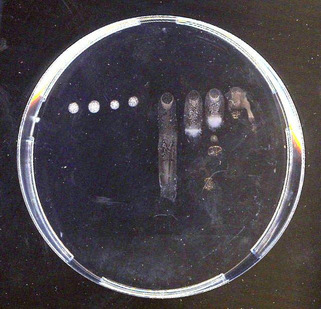
Bacteria, which can be found in a variety of environments, have developed among the richest set of locomotion mechanisms both at the microscopic and collective levels. Their understanding has implications ranging from the design of novel active systems to the control of microbial populations. I will present experiments on a new mode of collective bacterial motility in humid environment through the depinning of bacterial droplets.
While capillary forces are notoriously enormous at the bacterial scale, even capable of pinning water droplets of millimetric size on inclined surfaces, we show that bacteria are able to harness a variety of mechanisms to actively unpin contact lines, hence inducing a collective slipping of the colony across the surface. This `colony surfing’ is faster than other known migration modes like swarming although it does not depend on the bacterial flagella. The microscopic mechanisms used by the bacteria to vastly enhance their substrate wetting capability could each play a role in the migration of microorganisms in natural humid environments.
-
Conference on the Navier-Stokes equation [2016-11-16]
The Navier-Stokes equations - mathematical & physical point of view
Thursday january 26th, 2017 at 17h. Amphi 2A, Halle aux Farines (2 rue Marguerite Duras 75013 Paris), Univ. Paris Diderot
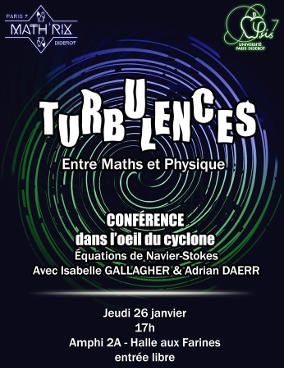
The Navier-Stokes equations are the century-old fundamental equations describing the flow of fluids. They are merely a rewrite of Newton’s law f=ma for a continuous medium submitted to external forces as well as pressure and friction forces. Yet the equations are so difficult so solve that the Clay Mathematics Institute offers is a one million dollar prize for substantial progress on understanding the existence and smoothness of solutions to the Navier-Stokes equations for arbitrary initial conditions. In the meantime we learned how to build airplanes and we boldly fly without knowing for sure whether finite time singularities may put a sudden end to our journey. While physicists and engineers use dirty tricks to get at least approximate solutions for real world flows (or so they believe), mathematicians are being more careful, identifying those cases where solutions can be proven to actually exist and behave (as e.g. in two dimensions). In this conference (in french) a mathematician (Isabelle Gallagher) and an experimental physicist (Adrian Daerr) exchange on the Navier-Stokes equations and the different approaches.
-
Meanders on a partially wetting incline [2016-01-24]
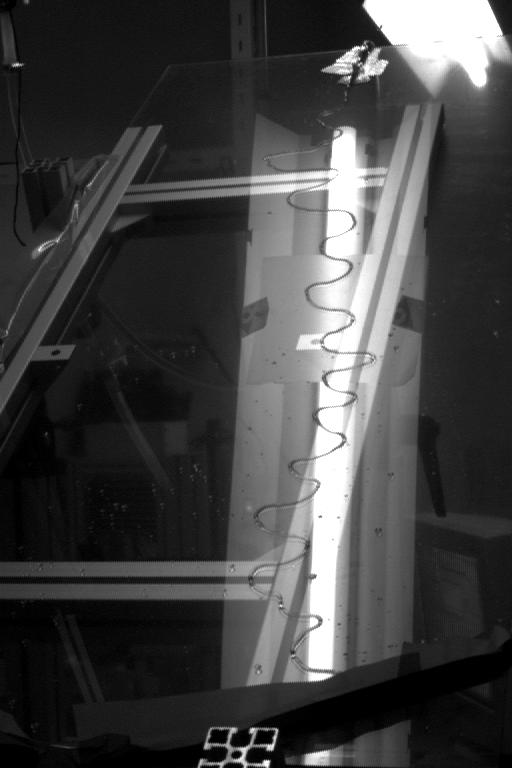
It’s always fascinating to watch a small rivulet of water slowly creep across the plane (it can last for over an hour) and change its path, growing new bends, as if it were a river shifting its bed. When finally the pattern becomes stationary, the turning radius is given by the wetting properties of the substrate. It is the tightest bend the water that makes up the rivulet can follow, given its velocity, without sliding outwards. At the end it looks as if it was swaying left and right in the same manner as a skier on a slope of fresh powder snow.
-
Cross-hatched erosion pattern on a beach [2015-12-30]
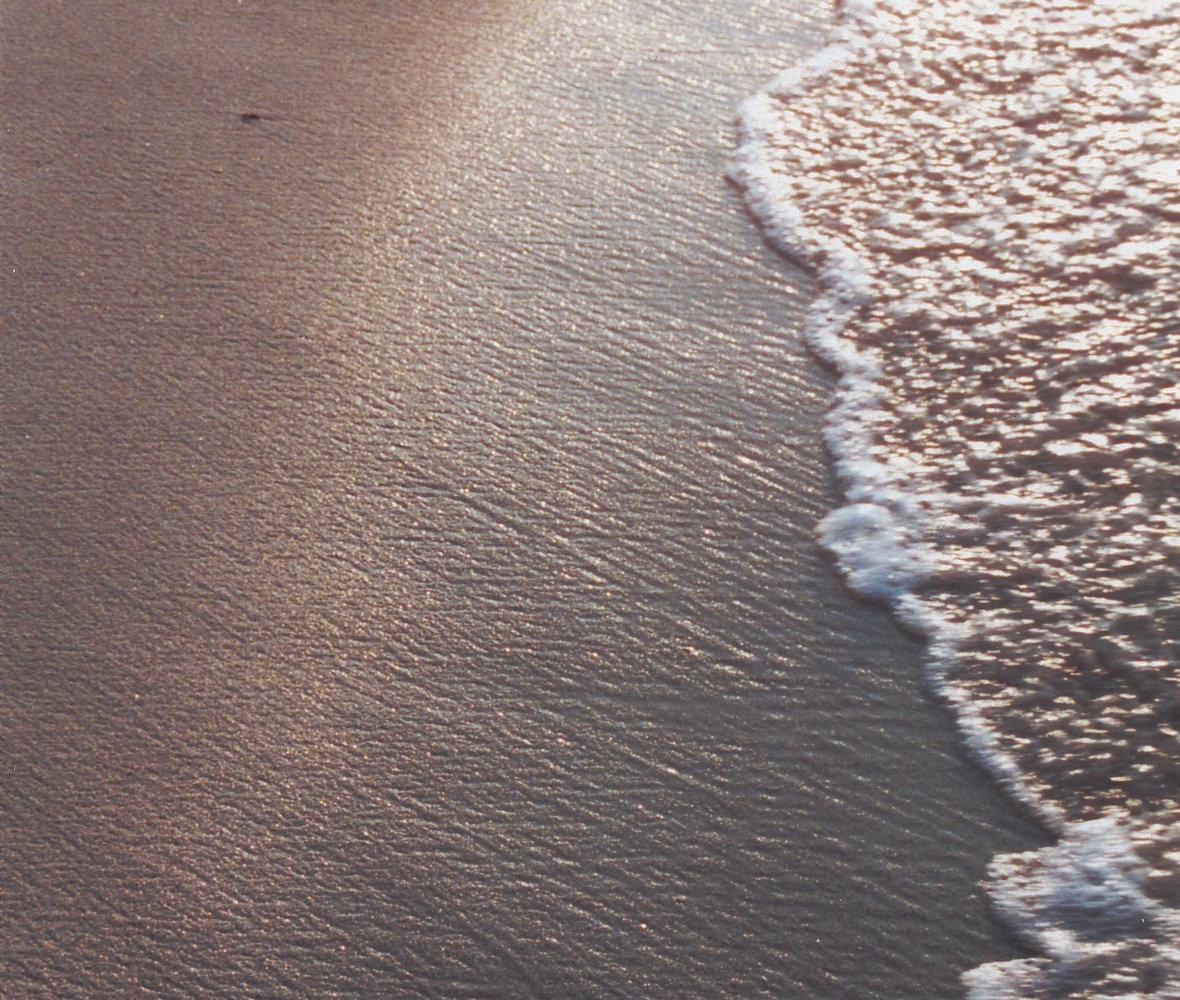
The receding swash on this beach creates grooves not along the direction of steepest slope, but at a well defined angle to it. This results in a cross-hatched pattern reminiscent of what we observed in a [laboratory erosion experiment][erosion] at weak slopes in powder layers. -
Water drop on a hydrogel [2015-10-24]
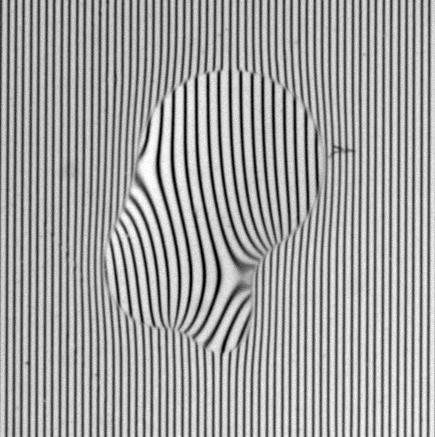
Coalescence of water drops on the surface of an Agar hydrogel. Similar to the previous post, but less symmetric. -
Seminar 2015-10-26 @ Gulliver / ESPCI [2015-10-22]
Wetting Dynamics and Mass Swarming of Bacillus Subtilis over Soft Gel Substrates
Monday the 26th of October 2015, 11:15 am, ESPCI, building F, room F3.04
Summary: Bacillus subtilis forms dendric colonies on gel surfaces through the collective motion of groups of 10^4 to 10^5 cells which form the compact tips of elongating dendrites. We investigate some physical aspects of this phenomenon, for which humidity and the surfactant production by the bacteria play as much of a role as does the motility of the hyperflagellated swarmer cells. I will present observations at different spatial and temporal scales which yield a wealth of information that cannot be simply inferred from the final colony shape. In particular we can learn which physical interactions between bacteria and the gelose substrate regulate the dynamics of mass swarming. Finally I will discuss a novel mode of locomotion, tentatively termed “mass sliding” or “colony sliding”, which we discovered with a modified experimental protocol.
Planning & info: https://gulliver.spip.espci.fr/spip.php?rubrique26
-
Water drop on a hydrogel [2015-10-08]
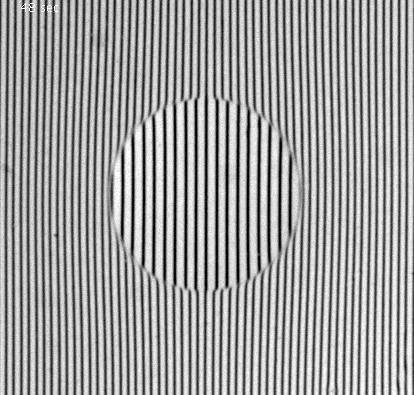
This photograph shows a small water drop resting at the surface of a hydrogel (Agar). The transparent drop is made visible through the deformations of a grid of black lines placed behind the drop. Surprisingly enough, the drop only partially wets the gel which contains more than 99% of water, instead of completely spreading. The strip-videograph below shows how, within minutes, the drop slowly disappears into the gel, first by flattening with fixed contact lines, and then by shrinking in diameter. This illustrates that a gel can be seen as a sort of molecular sponge that can take up its solvent. Notice how the gel around the drop is swelling.
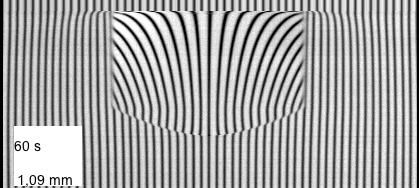
Space-time diagram (aka strip-videograph, aka kymograph) showing a horizontal line through the centre of the drop above, evolving with time (time progresses from top to bottom).
Last modified: 18 Jul 2020